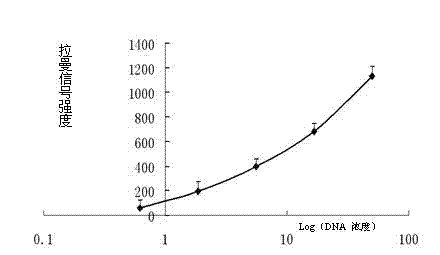Method for preparing Raman sensor based on gold nanorod self-assembly under polymerase chain reaction
A gold nanorod, self-assembly technology, applied in biochemical equipment and methods, bioreactor/fermenter combination, bioreactor/fermenter for specific purposes, etc., can solve the problem of lack of effective methods for Raman sensors, etc. , to achieve the effect of enhancing Raman detection of nucleic acids
- Summary
- Abstract
- Description
- Claims
- Application Information
AI Technical Summary
Problems solved by technology
Method used
Image
Examples
Embodiment Construction
[0020] The preparation of gold nanorods, the preparation of gold nanorods utilizes the gold seed growth method.
[0021] Synthesis of gold seeds: 2.5 mL of 0.0005 M chloroauric acid (HAuCl 4 ) was dissolved in 2.5mL of 0.2M cetyltrimethylammonium bromide (CTAB), mixed evenly, and 0.3mL of newly prepared, pre-cooled 0.01M sodium borohydride solution was quickly added to the above solution, And vigorously mixed for 2 minutes, then placed at room temperature 25 ° C for 2 hours, ready to use.
[0022] For the growth of gold nanorods, the configuration of the growth solution: 0.15mL, 0.004M AgNO 3 , 5mL, 0.001M HAuCl 4 Add the solution to 5mL, 0.2M CTAB, then add 70μL of 0.0788M Vc, fully reduce for 2min, add 12μL of the above-mentioned gold seeds, stir fully for 20s, and then stand at 25°C for use.
[0023] Directional modification of gold nanorods. The modification method is end surface modification, the synthesized gold rod, the concentration is 2nM, centrifuged at 10000r / mi...
PUM
 Login to View More
Login to View More Abstract
Description
Claims
Application Information
 Login to View More
Login to View More - R&D
- Intellectual Property
- Life Sciences
- Materials
- Tech Scout
- Unparalleled Data Quality
- Higher Quality Content
- 60% Fewer Hallucinations
Browse by: Latest US Patents, China's latest patents, Technical Efficacy Thesaurus, Application Domain, Technology Topic, Popular Technical Reports.
© 2025 PatSnap. All rights reserved.Legal|Privacy policy|Modern Slavery Act Transparency Statement|Sitemap|About US| Contact US: help@patsnap.com

